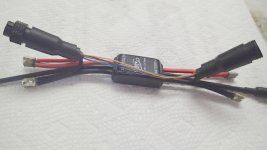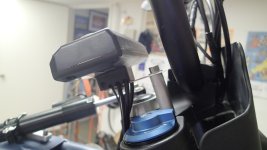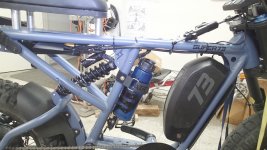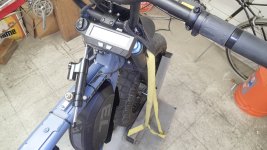These controllers were already configured to connect to a Cycle Analyst and I use the CA's tocontrol the controllers and to display information about thre ride data like state of charge, Ah/mi, speed, distance, etc.
All of that information is generated inside the CA, not the controller.
Now I have a different situation where I did not choose the controller and my goal is to get the data display but also keep the few ride choices that the Super73 hs available on it's minimal dash. Such as class choice (1,2,3, & private land).. 4 levels of PAS are also selectable on the OEM dash.
You will need the display that is part of the controller/display system, and it's controls, to use the functions that ocntroller has built in, and to display any data from that controller.
The CA cannot do this because it cannot communicate with *any* controller to send or receive any data.
(it does have a serial port that it can receive data on to change it's settings via the computer-based setup program, and it can send realtime data out that it is generatingg that you see on the display for battery info, etc, but it's not used to talk to controllers)
It is highly likely that nothing else besides the original display/etc can do the job either, unless you reverse engineer the communications and datastream and make one yourself, unless there happens to be the same protocol and firmware / etc display out there somewhere, but hten it will still really be the same thing you already have, evven if it looks a bit different. THere are numerous protocols and choices of datasets, settinggs, etc, for diffferent controller/display combinations, and theya re genrally not intercompatible).
This is all a PITA, but it's the state of things at present.
There is a small cable coming out of the BB but I don't know if it is a torque sensor or just a rotatin detector. If it is actually a torque sensor then I would want to move that selection to the Cycle Analyst.
<snip>.
It would be great if someone out there can identify whether the BB is a torque sensing one or just a rotation sensor. There is a small cable coming out of the BB housing.
What does that cable have for wiring? If it's just three wires it's probably a cadence-only sensor. If it has four+ wires, it could be a torque+cadence sensor.
Does the cotnroller operate normally via throttle only if you unplug this cable from it? If it does not, and has no setting to correct that, then you can't move the cable to the CA because the cotnroller won't operate without the signal from it. There are some controllers like this.
In that event you'd need to replace the controller (and any display it uses) with one that accepts just a throttle siganl for all of it's operation.
If there are any functions of the controller / system that you use the pedals to control, you would need to keep that connection for that reason. Otherwise those functions would be lost.
BTW, even if it is just a cadence sensor, you can get much better control over operation via pedals using hte CA to read the sensor and create a throttle signal to operate the controller just as if you were operating the thorttle via the pedals, assuming the controller will oeprate without the pedal signals.
This is because most controllers only use the cadence sensor as on/off, either you're pedalling or you aren't, and it doesn't care how fast or slow you're pedalling. It just triggers the full power or speed of the controller as setup for the presnetly-chosen assist levvel.
But the CA counts pulses and how quickly they happen and increases or decreases the throttle signal based on that and your chosen settings, so it actually directly controls the motor speed (or torque/etc depending on the mode you choose in the CA, and how t he controller works). I use this mode to control my SB Cruiser trike via pedals (it has a thorttle, but it's more a go-button to start me off in situations i can't get going via pedals, or the times when my legs cannot operate the pedals correctly).







